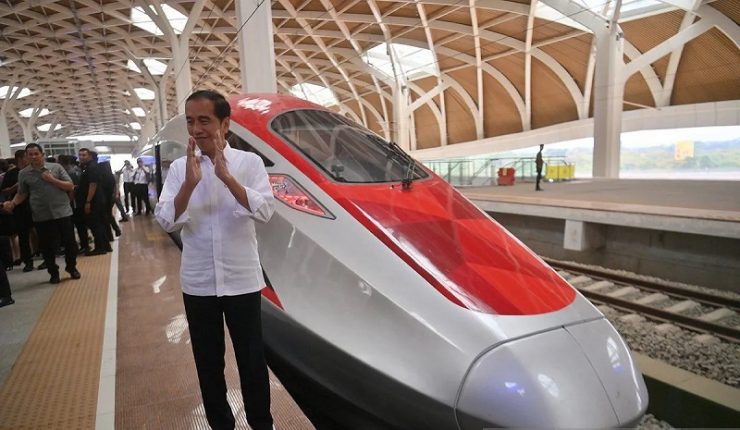THE OPERATION of the Whoosh Fast Train is a new milestone for the transportation provision industry in Indonesia. Various information and communication technology (ICT) solutions are embedded to optimize the digital-based high-speed train operating system.
Behind its function as a mode of transportation, the Whoosh Fast Train also plays a role as a key infrastructure capable of supporting the smart city concept.
This is because the Whoosh train has connected two cities that have implemented ICT-based city management so that it is more efficient in utilizing existing shared resources, namely DKI Jakarta and Bandung.
The presence of the Whoosh train can support the vision of the two smart cities because it supports sustainable, inclusive, environmentally friendly, efficient and effective solution initiatives to support the mobility of urban communities living between the two cities.
As a sustainable solution, the Whoosh train is a solution innovation and helps break down mobility barriers that have occurred with motorized vehicles.
Apart from reducing traffic density, its presence is also expected to reduce fossil energy consumption which will lead to cutting carbon emissions. So, it is not surprising that the Whoosh Fast Train is expected to contribute to helping the government realize the “Net Zero Carbon” target by 2060.
Fast Train Multiplier Effect
The development of the train network, both conventional trains and high-speed trains, has a multiplier effect which is very beneficial for the social and economic life of the community.
Based on a study by the British Railway Industry Association (RIA), every GBP 1 spent on building a train network will create a multiplier effect in the form of broad economic benefits which, if calculated, reaches GBP 2.20.
Behind the high-speed train project is a large investment to build infrastructure and supporting facilities that use today’s leading technology.
Automatically, this project will also create thousands of quality job opportunities. Based on KCIC data, the Whoosh Fast Train Project has absorbed more than 13,000 local workers.
Apart from that, until February 2022, the Whoosh Fast Train Project has also contributed IDR 5.34 trillion to the state in the form of state revenue from taxes and non-tax state revenue (PNBP).
Meanwhile, in terms of project procurement, procurement of goods and services for the Whoosh Fast Train project, the portion reached 69.7% of the total project procurement expenditure. The collection of facts above is clear evidence of the positive multiplier effects of the presence of this project.
Implementation of Railway Digital Solutions
In the Whoosh Fast Train project, Huawei and China Railway Signal and Communications (CRSC) collaborated to build a communications network using CTCS level 3 technology, a train control system standard that has been used on more than 40,000 km of railway lines in China.
To deploy CRSC’s CTCS support network, Huawei uses wireless technology on the 900 MHz frequency, which had previously been vacated along the high-speed train line which covers 142.3 kilometers.
“As we know, fast trains generally travel at high speeds and have short departure intervals. We have to ensure that fast trains can run safely, smoothly and efficiently,” said Huawei Indonesia Vice President Lai Chaosen.
In addition, Huawei already has solutions such as train-to-ground wireless signaling systems, signal transmission and data networks for high-speed trains. This solution has been very helpful in building a reliable communications network for Whoosh Fast Train operations.
The Whoosh Fast Train data network uses DataCom’s latest generation equipment which is claimed to be 100% safe from physical damage thanks to high strength pipe technology.
The entire transmission network is protected by a redundant system with a switching time speed of tens of milli per second. This switching speed ensures that data exchange flows can run smoothly even if there is interference.
Lai Chaosen added that the Whoosh Fast Train signaling transmission system is also supported by the latest generation of equipment from Huawei.
This device is claimed to be able to operate on large bandwidth systems and has high stability for use in more than 20 systems, such as fast train accident response systems, electric power control, and train ticket sales.
Strengthening Indonesia’s Competitiveness
Investment in the transportation sector can act as a catalyst to leverage a country’s growth and per capita income. The Whoosh Fast Train Project carries the hope of increasing efficiency in the transportation sector, which in turn will encourage economic actors to be more efficient.
his condition will have a positive influence on the formation of increasingly competitive prices. A series of infrastructure developments in the country have so far produced positive results.
Based on the IMD Global Competitiveness Index 2023, Indonesia has been able to improve its position and rose 10 places, from 44 to 34. The Whoosh Fast Train is expected to contribute more to improving Indonesia’s competitiveness in the future.
KCIC President Director Dwiyana Slamet Riyadi said technology solutions and railway infrastructure were vital to supporting the smart, safe and comfortable operation of the Whoosh Fast Train.
With the support of this advanced railway technology, the Jakarta-Bandung journey can be completed in just 40 minutes. Automatically, the distance of hundreds of kilometers from Jakarta to Bandung becomes meaningless, especially for business people and professionals with high mobility.
Indonesia’s success story in operating the first high-speed train network in Southeast Asia can be a reference for other countries in the region and Asia at large.
“The combination of implementation between established technological solutions and Huawei and CRSC’s operational solutions used on the Whoosh Fast Train can be a reference and reference in the development of other fast train infrastructure in Indonesia and similar projects in other countries in the ASEAN region,” Dwiyana concluded. [antaranews/photo special]
















